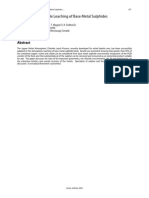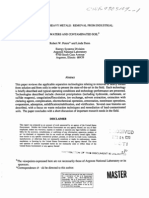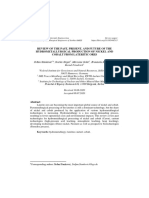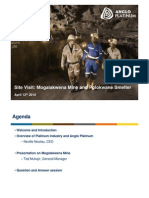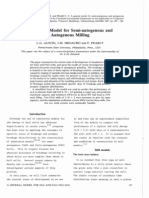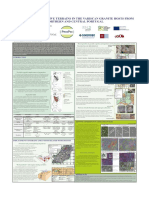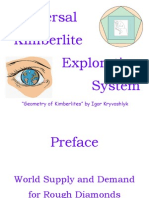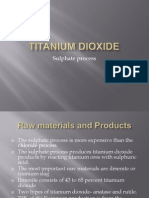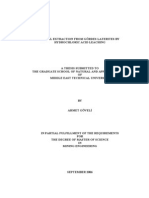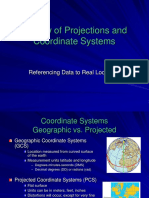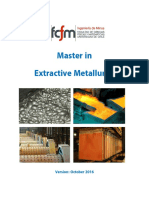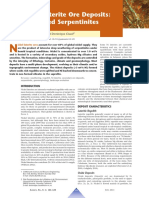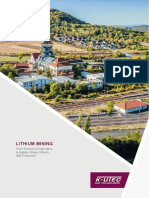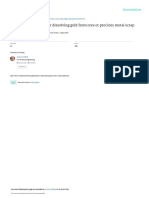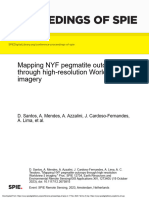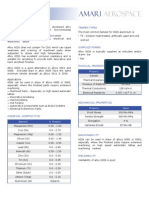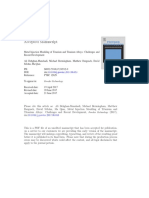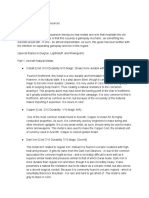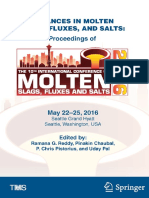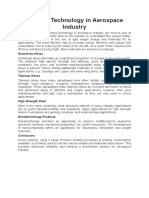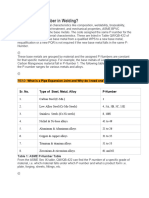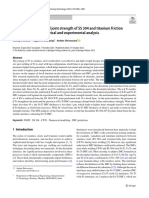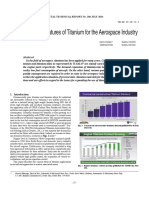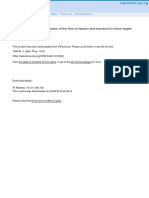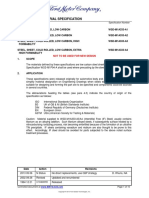Iluka Pro Rata Entitlement Offer Appendix Mineral Sands Industry Overview
Iluka Pro Rata Entitlement Offer Appendix Mineral Sands Industry Overview
Uploaded by
Giang NguyenCopyright:
Available Formats
Iluka Pro Rata Entitlement Offer Appendix Mineral Sands Industry Overview
Iluka Pro Rata Entitlement Offer Appendix Mineral Sands Industry Overview
Uploaded by
Giang NguyenCopyright
Available Formats
Share this document
Did you find this document useful?
Is this content inappropriate?
Copyright:
Available Formats
Iluka Pro Rata Entitlement Offer Appendix Mineral Sands Industry Overview
Iluka Pro Rata Entitlement Offer Appendix Mineral Sands Industry Overview
Uploaded by
Giang NguyenCopyright:
Available Formats
107
APPENDIX
Mineral Sands Industry Overview
108 This Section provides an overview of the mineral sands
industry and market as well as Ilukas competitive
position within the global market. This Section includes
forward-looking statements that may be affected
by a range of variables and changes in underlying
assumptions which could cause actual results to differ
materially. These include, but are not limited to, the
risks discussed in Section 6 of this Prospectus.
A1 Overview
Mineral sands represent a relatively small, niche part of
the global resources sector. The mineral sands industry
consists of two core product streams:
Titanium dioxide minerals in the form of rutile,
ilmenite and leucoxene. Ilmenite is also used to
manufacture titanium slag and synthetic rutile
products; and
Zircon.
Titanium dioxide products are more prevalent than
zircon, with an average titanium dioxide to zircon ratio
of 5:1 in typical mineral sands deposits. Mineral sand
products (titanium dioxide and zircon) are used in a
wide and increasing range of consumer and industrial
applications. The predominant use of titanium dioxide
is as a pigment feedstock for paint manufacture, as
well as in specialist applications including welding
electrodes and titanium metal. Zircon is currently used
predominantly in the manufacture of tiles, ceramics
and sanitary ware, although it has a range of other
applications including zirconium chemicals and
zirconium metal.
The industry has typically displayed growth rates which
have correlated closely with global economic growth
rates. Increasingly, there is evidence of strengthening
in demand for mineral sands products from developing
regions and economies, such as China and to a lesser
extent India, where the products are associated with
both industrialisation and increasing urbanisation.
Since 2000 demand growth from these markets has
exceeded that for the more established markets such
as Europe and North America.
The global titanium dioxide feedstock market
was estimated at 6.0 million tonnes of titanium
dioxide units in 2007, and generated approximately
US$2.0 billion in revenue. Zircon has been generally
regarded as a co-product of titanium dioxide feedstock
production. The global zircon market in 2007 was
estimated at around 1.25 million tonnes and generated
approximately US$0.9 billion in revenue. The industry
is relatively consolidated on the producer side, with
ve participants accounting for approximately 57% of
global titanium dioxide production and ve participants
accounting for approximately 75% of zircon production
in 2007. In terms of customers, the titanium dioxide
market is relatively consolidated with, for example,
Ilukas top 10 customers accounting for 85% of its
titanium minerals sales revenue. The zircon market
is less consolidated with, for example, Ilukas top 10
customers making up approximately 50% of its zircon
sales revenue.
The mineral sands industry is typically characterised
by contractual arrangements, involving bulk shipments
contracted on a volume and price basis for a set period,
typically of at least 12 months. Only a relatively small
spot market exists for mineral sands products and there
is no screen traded equivalent in mineral sands.
In Ilukas case, volume commitments are often entered
into with major customers over multiple years, usually
with annual price negotiations for most products.
Iluka is the largest global producer of zircon with an
estimated 37% market share in 2007 and is the second
largest producer of titanium dioxide products with an
estimated 20% market share in 2007.
1
A1.1 Mineral Sands Technical Background
Mineral sands is the term used to describe Heavy
Minerals (HM) with a specic gravity greater than
2.85. These minerals were produced by weathering
and erosion of the earths surface and were carried by
sedimentary action to coastlines where a combination
of wave action (strand deposits) and, to a lesser extent
wind action (dunal deposits), resulted in concentrations
in bodies of silica sand along ancient beach lines and
associated environments.
The major known locations of mineral sands ore bodies
are in Australia, India, southern Africa and southern
USA. The majority of mineral sands occur in sand
style deposits, although the titanium-bearing mineral,
ilmenite, is also mined from hard rock deposits in
Canada, China and Norway. Australias mineral sands
deposits occur along the coast of eastern Australia
from central New South Wales to northern Queensland,
and in Western Australia. In addition, ancient beach
deposits are found in Victoria, New South Wales and
South Australia.
Mineral sands deposits are characterised by their
grade (the percentage of HM found in a deposit) and
their assemblage (the relative proportion of valuable
HM components of ilmenite, rutile and zircon).
The typical composition of a mineral sands deposit
Note:
1. Iluka, 2007 estimates. Includes 100% of CRL output, which Iluka markets on CRLs behalf.
Appendix Mineral Sands Industry Overview
109
Figure A.1: Titanium Feedstock Processing Routes
Source: TZMI
Sand Deposits
(Dredge or Dry Mining) Hard Rock Mining
Processing
Key Products
Ex Mine
Key Upgraded
Titanium Products
Major Pigment
Production
Processes
Final Products
End Uses
Wet Concentration
Dry Concentration
Leucoxene Ilmenite
Synthetic Rutile Titanium Slag
Chloride TiO
2
Process
Titanium Tetrachloride
TiCI
4
High Purity Pig Iron
Sulphate TiO
2
Process
White Pigment
Foundries Paints Plastics Paper Other
Inks
Ceramics
Fibres
Aerospace
Chemical
Plants
Golf Clubs
Welding
Electrode
Flux
Opacifiers/
Glazes
Refractories
Zirconium
Chemicals
Abrasives
Titanium Metal
Titanium Sponge
Rutile Zircon
has a HM grade ranging from 0.5% to above 20%,
with titanium dioxide products normally being in the
greatest preponderance, relative to zircon.
A unique feature of titanium dioxide minerals is that
commercial products have a wide range of titanium
dioxide and impurity contents. This can range from
as low as 40% titanium dioxide for some ilmenites
to as high as 96% titanium dioxide for some natural
rutile. Pricing for these products ranges from as low
as US$50/t to over US$600/t depending on grade
and end-use application. In addition, the price of
co-products such as zircon and pig-iron (a co-product
of titanium slag see Figure A.1) has risen substantially
in recent years. The value of a mineral sands deposit
is inuenced by grade (a cost of mining issue),
assemblages (value of the relative product streams),
upgrading technology (slag or synthetic rutile), depth
(quantity of overburden to access Ore Reserve) and
location (distance from infrastructure and markets).
The following diagram illustrates the main stages of
the titanium feedstock production process from mining
through to nal product production.
110
Rio Tinto
1
21%
Iluka
2
20%
Exxaro
3
7%
BHP Billiton 7%
Bemax 3%
Tinfos 2%
Tiwest JV 2%
DuPont 1%
Other 37%
Iluka
2
37%
Exxaro
3
13%
Rio Tinto
1
8%
BHP Billiton 8%
Bemax 5%
DuPont 4%
Tiwest JV 3%
Other 22%
A1.2 Mineral Sands Markets
Industry Structure
As noted above, the mineral sands industry is relatively
consolidated. This relatively consolidated structure
arises from the capital intensive nature of the industry,
the specialised technologies, and the importance of
quality and continuity of supply to customers. Figures
A.2 indicates the consolidated nature of the industry,
and also highlights Ilukas presence in both markets.
The global titanium dioxide feedstock market can be
divided into chloride and sulphate feedstocks, which
reect the technologies used to upgrade the feedstocks
to titanium dioxide pigment.
Iluka is the largest producer of chloride
feedstocks, with a market share of around 27%.
Chloride feedstocks constitute: rutile, synthetic
rutile, chloride slag, upgraded chloride slag (UGS),
chloride ilmenite and leucoxene. Sulphate feedstocks
constitute: sulphate slag, sulphate ilmenite. Refer to
Appendix A2.2 for further information on the titanium
dioxide pigment sector.
Iluka (including CRL) is the worlds largest supplier
of rutile, synthetic rutile and chloride ilmenite, and the
second largest supplier of sulphate ilmenite. Ilukas
sales tonnages and estimated market shares are shown
in the following table:
Figure A.2: Major Titanium Dioxide Feedstock and Zircon Producers, 2007 estimates
Titanium dioxide feedstock Zircon
Source: Iluka and TZMI estimates
Notes:
1. The titanium slag products of Rio Tinto and BHP Billiton are currently marketed by Rio Tinto.
2. Includes 100% of CRL output, which Iluka markets on CRLs behalf.
3. Exxaro has a 50% interest in the Tiwest JV.
Table 1: Ilukas Estimated Market Share by Titanium Dioxide Feedstock in 2007
Iluka Global Estimate Market Share
Product kt kt % (estimate)
Rutile 215 620 35
Synthetic rutile 527 800 66
Chloride ilmenite 399 960 42
Sulphate ilmenite 518 3,860 13
Source: Iluka
Note: The above gures include 100% of CRLs titanium dioxide product sales which are marketed by Iluka.
Mineral sands deposits have differing grades of HM
and assemblage characteristics which can inuence
the relative cost and value stream of product produced
from any specic deposit. As such, the co-product
revenue stream is very important to feedstock industry
performance. Co-products include zircon and, in the
case of some slag producers, high purity pig-iron
produced as a by-product from slag operations.
Ilukas operations are based predominantly within
Australia, whereas many of the other leading producers
have large operations within southern Africa. A number
of new mineral sands projects have recently started
in Africa. These include the restart of rutile mining
in Sierra Leone, the recent commissioning of a large
ilmenite project in Mozambique and a small zircon/rutile
mine in Gambia. In addition, Rio Tintos titanium slag
expansion plans are centred around a large new mining
operation in Madagascar.
Appendix Mineral Sands Industry Overview
111
Pigment 93%
Metal 4%
Welding 3%
Paint & Coatings 53%
Plastics 22%
Paper 8%
Other 10%
A2 Titanium Overview
A2.1 Product Uses and Main Applications
Titanium dioxide minerals are used mainly as
feedstock for the worlds titanium dioxide pigment
industry with approximately 93% of product used in
the production of pigment (Figure A.3). As a pure
white, highly refractive and ultraviolet light absorbing
product, titanium dioxide pigment is commonly used
in architectural and automotive paints, plastics,
paper, textiles and inks. Titanium dioxide feedstock
is also used in the manufacture of welding electrodes.
Because titanium minerals are non-toxic, non-brogenic
and biologically inert, they can also be used safely in
foodstuffs, pharmaceuticals and cosmetics.
Rutile, synthetic rutile and slag can be used to make
titanium metal. Due to the combination of strength
and lightness of titanium metal, it is used for advanced
engineering applications, including architectural
coatings, the aerospace industry as well as a range of
other applications, including sporting equipment and
jewellery. Titanium metal is also used in desalination
plants and corrosive chemical industries, because of its
inertness and resistance to corrosion. Its non-reactive
properties make titanium metal one of the few materials
that can be used in the human body for hip replacements
and heart pacemakers.
Rutile, leucoxene and small amounts of ilmenite are
also used as a ux material in welding electrodes for
shipbuilding and civil engineering.
A2.2 Titanium Dioxide Pigment Industry
Accounting for 93% of consumption, the titanium
dioxide pigment industry is by far the most important
market sector for titanium dioxide minerals.
The pigment industry is primarily reliant on demand
from the traditional paints and coatings sector
(56%) and the faster-growing plastics sector (24%).
According to TZMI, the overall consumption growth
has consistently been around 3.0% p.a. for the
past 40 years and global titanium dioxide pigment
consumption is estimated at having been around
4.9 million tonnes in 2007.
Geographically, the major markets for pigment
are the developed regions of North American and
Western Europe (accounting for about 28% of global
consumption each in 2006). The next largest regions
are China (17%) and the rest of Asia Pacic (16%).
However, China is the region which has showed the
greatest growth over the past decade, with TZMI
estimates indicating that China consumed less than
10% of global pigment in 2000.
According to TZMI, there is still very little risk of any
signicant substitution for titanium dioxide pigment in
its major end markets. As has been the case for the past
40 years, particularly in the paint and coatings industry,
there will continue to be the potential for substitution
in selected markets but volumes are not expected
to be large. Titanium dioxide pigment still has very
substantial advantages over currently known alternative
products and more uses are continuing to be identied
in niche markets, such as nano-particles, through
persistent research and development efforts.
Figure A.3: Breakdown of Titanium Dioxide Feedstock Markets by End-Use Sector, 2006
Source: TZMI and Iluka
112 Pigment production is highly consolidated with the top
ve producers accounting for almost 67% of global
production capacity in 2007. The market leader is
DuPont, with a market share of about 20%, while
the other major producers include Cristal (16%)
Tronox, Kronos and Huntsman (each with about an
11% share of capacity). Most of these producers
have production facilities centred on North America
and Western Europe, which have historically been the
largest markets for pigment. In 2007, global pigment
production from over 110 plants was estimated by
TZMI to be around 5.1 million tonnes, an increase of
1.5% over 2006, valued at close to US$10.5 billion,
with 87% capacity utilisation.
Pigment production is divided into two types of
manufacturing technology: the chloride and sulphate
processes. The chloride process, which utilises a
chlorinating process, accounts for about 55% of all
pigment production and typically consumes feedstocks
of high grade and high value (such as rutile, synthetic
rutile and chloride slag).
The sulphate pigment process which utilises a sulphuric
acid digestion process, accounts for the remaining
45% of all pigment production and typically consumes
feedstocks of low grade and low value (such as ilmenite
and sulphate slag).
Chloride technology is generally newer, more efcient
and generates less waste than sulphate technology.
It is forecast that the capacity of this process will grow
faster than that of the sulphate process. However,
despite sulphate capacity reductions in the western
world, China continues to expand its sulphate capacity
very rapidly (growing approximately 17% pa over
the ve years to 2006 in terms of installed pigment
capacity). Sulphate capacity is, however, expected to
decrease after 2011 in China as local producers move
towards the production of higher quality pigment by
using the chloride process. This change is expected to be
inuenced by the need for pigment producers to reduce
waste and maintain higher environmental standards,
ensure a higher quality and more consistent product,
as well as increase pigment product output efciency
relative to feedstock input.
A2.3 Trends in the Titanium Dioxide Industry
The information in this Section is sourced from a
TZMI report commissioned by Iluka in January 2008.
TZMI believes that for the period to 2015 the pigment
industry is likely to exceed the long term average
3.0% pa growth rate trend achieved since 1970, as
there is currently not expected to be any marked slow
down in demand for titanium dioxide pigment in China.
The growing demand base for China begins to lift the
global demand growth rate as the size of the Chinese
demand achieves signicant global proportions.
The regional contribution to this growth will certainly
be uneven. In the mature developed economies of
North America and Western Europe the underlying
consumption growth rate is likely to be 1% to 2% per
annum, consistent with recent performance. This lower
rate should be counterbalanced by the continuing rapidly
growing demand in the Asia-Pacic region which has
averaged 6.7% pa over the last 10 years and is forecast
to average 6.1% pa to 2015. In China alone, TZMIs
titanium dioxide pigment demand forecast for 8.4% pa
would result in consumption of 1.7 million tonnes by
2015, a level that would take Chinas consumption
beyond that for Western Europe and North America.
Global pigment production capacity has to expand to
accommodate the projected increase in consumption,
so capacity additions are expected to be a major feature
in the period to 2015, led by China. Further expansions,
beyond those already announced, as well as the closure
of selected plants, will occur in the period to 2015.
The major assumptions are highlighted below:
China titanium dioxide pigment capacity (including
non-pigmentary material) is expected to surpass
1.4 million tpa by 2009, with the top ve Chinese
producers likely to have individual capacities
of around 100,000 tpa. Total Chinese titanium
dioxide pigment production is expected to reach
1 million tonnes in 2010. A contributing factor to
this will be greater penetration of export markets
as product quality progressively improves over the
next few years.
By 2015, total installed Chinese titanium dioxide
capacity is forecast to be around 1.75 million tpa,
and is expected to include some 425,000 tpa of
new chloride capacity, including DuPonts planned
Dongying chloride plant, forecast to commence
operation in 2011.
The emergence of a highly competitive and expanding
Chinese pigment sector will place pressure on several
higher cost European and Japanese plants, leading
to the closure by 2015 of over 300,000 tpa capacity
associated with the less efcient sulphate process
plants. Plant closures will probably be a combination
of outright closure with some plants closing only the
front end and purchasing raw pigment from other low
cost plants.
In North America, no new greenelds capacity is
assumed during the period to 2015, but capacity
growth is expected to be achieved through expansion
and debottlenecking at many of the major plants.
Capacity increases totalling 208,000 tpa are forecast,
taking installed capacity in the region to just under
2.0 million tpa.
Appendix Mineral Sands Industry Overview
113 Capacity in Western Europe is forecast to
expand only modestly over the next 10 years by
debottlenecking at several of the larger plants owned
by the global producers. A large proportion of the
capacity expansions should be offset by the closures
mentioned above.
Central and Eastern European ilmenite based
sulphate plants also seem likely to expand production
by over 160,000 tpa.
Based on expected strong demand for titanium
dioxide pigment and its vast ilmenite reserves,
Indian pigment capacity is expected to expand by
around 270,000 tpa by 2015, with most growth
assumed to come from one new chloride and one
new sulphate facility.
In other regions, existing capacity at DuPonts
Mexico plant and Cristals Saudi Arabia plant is
expected to undergo further expansion, while a new
greenelds chloride facility is possible in South Africa
or South America.
There is also considerable potential for raw pigment
to be shipped from cheaper plants in Asia-Pacic for
nishing and distribution in Europe.
Overall, global production capacity is expected to
expand to over 7.3 million tonnes by 2015, equivalent
to an additional 1.63 million tpa, with the chloride
process responsible for approximately 70% of the total
net increase.
A2.4 China and Other Growth Markets
The information in this Section is sourced from a TZMI
report commissioned by Iluka in January 2008.
As China continues to grow it is expected to
progressively adopt the chloride process. In addition
to Chinas existing single chloride plant in Jinzhou,
Liaoning Province, the rst major step towards a
world-class facility is only expected to come early
next decade when DuPont is planning to commission a
200,000 tpa plant at Dongying in Shandong province.
TZMI is projecting additional chloride process plants
to be built in China and it is expected that the chloride
process will account for around 20% of the countrys
pigment output by 2015. China should emerge as a net
pigment exporter by 2016.
Capacity growth within China is still seen by most
industry participants as the only way to survive the
threat of major international pigment companies
installing their own facilities in the country. However
in over the last 12-18 months the pace and nature of
capacity growth is changing.
Several factors are now adding a new dimension to
acquiring or developing technology leading to some
recent slow-down in project execution, including:
increased domestic competition, following
cancellation of the 13% export rebate from
July 2007;
increasing threat of foreign competition, fuelled
by the planned DuPont Dongying plant;
increasing cost pressures coming from rising
raw materials, energy and labour costs; and
increasing cost pressures, due to stricter enforcement
of environmental requirements.
0
1,000
2,000
3,000
4,000
5,000
6,000
7,000
Tonnes
(000)
China
Other Asia Pacific
Western Europe
North America
Other
2002 2005 2010f 2015f
0
1,000
2,000
3,000
4,000
5,000
6,000
7,000
Tonnes
(000)
China
Other Asia Pacific
Western Europe
North America
Other
2002 2005 2010f 2015f
Figure A.4: Growth of Pigment Consumption and Production by Region
Pigment Consumption Pigment Production
Source: TZMI
114 Since the Chinese industry is now somewhat
fragmented, acquiring skills and know-how is no
longer centralised and each manufacturer has to do
this on its own. Environmental impact requirements
are enforced more strictly and the process of obtaining
building permission is now more comprehensive and
time consuming, leading to an inevitable slow-down in
growth of new capacity at least in the short term.
The drive for increased size, now coupled with improved
efciency as to manufacturing cost and product quality,
plus improved environmental performance, will continue
to stimulate investment in new capacity. This will in
part be off-set by the closure of dated capacity and the
demise of smaller and inefcient producers
Demand for pigment in Asia-Pacic is expected to grow
from 1.58 million tonnes in 2006 to 2.8 million tonnes
by 2016, a compound annual growth rate of 5.7%.
China, South Korea and Japan are all key regional
markets. In the period to 2015 nearly 500,000 tonnes
of additional imports will be required by these three
countries. South Korea in particular looks to be a
prime candidate for a new greenelds plant within the
next 510 years, as it is currently served by two small
sulphate plants and a nishing plant.
In terms of demand potential, India has the greatest
claim. With just over one billion people and a current
apparent consumption of only about 130,000 tpa
(partly met by domestic production from four small
plants), Indias potential is enormous. Comparisons with
Chinas eight-fold increase in demand during this decade
are regularly made, but it should be recognised that the
rapid growth in China over the last 57 years has been
in most cases supported by all levels of government.
In India this is often not the case where the potential
economic growth is stied by legislative or bureaucratic
procedures. For that reason the growth rate for pigment
seems likely to be around 8% pa.
A2.5 Historical Titanium Dioxide Feedstock Prices
Historical rutile prices (in nominal US$/t FOB terms)
from 1970 to 2007 are shown in Figure A.5. The main
events inuencing pricing over this period of time are:
period of strong pigment demand together with
high titanium dioxide feedstock capacity constraints
between 1985 and 1990;
additional synthetic rutile and chloride slag coming
onto the market from 1990 until 1993/94;
closure of Sierra Rutile Limited (capacity of just over
150,000 tpa) in early 1995 pushed up the spot price
of rutile rapidly until 1996;
additional slag coming onto the market from Ticor SA
(now Exxaro) in 2002 dropped prices in 2003; and
since 2003 rutile prices have progressively re-aligned
with slag and synthetic rutile in relative economic
value terms.
Historical TZMI synthetic rutile prices start from 1980,
as this is when synthetic rutile production began on
a commercial scale. As with rutile, prices have been
sourced from TZMI and converted into nominal US$/t
FOB terms. Given that varying qualities of synthetic
rutile are produced by Iluka and others, the prices used
are those representing synthetic rutile with a grade of
92.5% titanium dioxide. It should also be noted that
a signicant proportion of synthetic rutile was sold
in Australian dollars until 20002003. The synthetic
rutile prices are shown Figure A.5. The main events
inuencing pricing over this period of time were:
period of high titanium dioxide feedstock oversupply
from new synthetic rutile and chloride slag capacity
from 1990 to 1993;
impact of closure of Sierra Rutile Limited in
early 1995;
2004 2007 2001 1992 1995 1998 1989 1986 1983 1980 1977 1974 1971
0
100
200
300
400
500
600
US$/tonne
Rutile Synthetic Rutile
Figure A.5: Historical Rutile and Synthetic Rutile Nominal FOB Prices
Source: TZMI
Appendix Mineral Sands Industry Overview
115
period of declining A$:US$ (most synthetic rutile
still priced in A$) and additional slag coming onto
the market; and
since 2003 synthetic rutile progressively priced in
US$ and prices re-aligned with slag and rutile in
relative economic value terms.
The historical TZMI ilmenite prices from 1980 indicate
that both sulphate and chloride ilmenite prices remained
low (less than US$30/t) until the mid 1980s and then
steadily increased until the early 1990s. During this
time sulphate ilmenite increased at a higher rate than
chloride ilmenite and a price differential of about
US$1015/t developed in the late 1980s. This price
differential remained until the early 2000s, when
chloride ilmenite prices continued to increase, but
the price of sulphate ilmenite dipped. The latter was
caused by additional ilmenite coming onto the market
from countries such as India and Vietnam. The pricing
variations between sulphate and chloride ilmenite reect
the different time horizons under which they are traded;
sulphate ilmenite is still priced on an annual basis (and
sometimes a spot basis) whereas chloride ilmenite is
often sold under multi-year contracts with some form
of price escalation year on year.
A2.6 Ilukas Interpretation of Pricing Trends in
Titanium Dioxide Feedstock
Iluka has recently completed an analysis of the long
term historical pricing trends of rutile, synthetic
rutile, chloride slag and chloride and sulphate ilmenite,
based on the TZMI sourced information contained in
Figure A.6.
Utilising a line of best t indicates a compound
annual growth rate (CAGR) of 4.3% for rutile prices
over the period displayed above (converted into nominal
US$/t FOB terms). Basing the line of best t from 1975
(as 1970 is considered a low period in rutile pricing)
results in a CAGR of 2.5%.
Synthetic rutile pricing history since the commencement
of production in 1980 was analysed in a similar
manner. Given that varying qualities of synthetic rutile
are produced by Iluka and others, Ilukas analysis
used prices for synthetic rutile representing a grade
of 92.5% titanium dioxide content. A signicant
proportion of synthetic rutile sold during 20002003
was done in Australian dollars and these prices have
been converted using average annual exchange rates
(refer to Section 6.2.3 for a description of certain risks
associated with currency exchange rate uctuations).
A CAGR of 2.7% was calculated for synthetic rutile
from 1970 to the end of 2007. A similar CAGR was
calculated for overall average high grade titanium
dioxide chloride feedstock prices.
Iluka does not publicly provide future pricing outcomes
for its products. However, since 2003, Iluka has
achieved average US$/t price increases for both rutile
and synthetic rutile in excess of the CAGR percentages
quoted above. Going forward prices will depend on the
global supply/demand balances for individual products.
As outlined in Section A4, the supply/demand balances
for titanium dioxide feedstocks are difcult to forecast,
as they rely heavily on the timing and success of new
projects coming on-stream. Refer to Section 6.2.6 for
a description of certain risks associated with the global
supply of mineral sands products.
2007 2001 2004 1992 1995 1998 1986 1989 1983 1980
0
20
40
60
80
100
US$/tonne
TZMI Sulphate ilmenite TZMI Chloride ilmenite
Figure A.6: Historical Ilmenite Nominal FOB Prices
Source: TZMI
116 A3 Zircon Overview
A3.1 Product Uses and Main Applications
Zircon is a hard, glassy mineral used for the
manufacture of ceramics and refractories and also
in a range of industrial and chemical applications.
Consumption is dominated by the use of milled zircon
powder as an opacier in ceramics applications for use
in tiles, sanitary ware and tableware. Zircon is also used
in refractories, television glass and foundry applications,
such as in the casting of jet turbine blades. Zircon is
the source material for zirconia and a wide range of
zirconium based chemicals. These products are used in
a multitude of high-technology applications, including
auto catalysts, fuel cells, electronics and abrasives.
Zirconium metal is used in nuclear fuel rods and in
specialist metal alloys due to its high melting point and
chemical resistance.
Associated with the established ceramics industries in
Italy and Spain, Europe remains the largest regional
market for zircon sand consumption. However, with
the rapid growth of the Chinese ceramic and zirconium
chemicals sectors, China has emerged as the single most
important country for zircon consumption in recent
years, accounting for almost 30% of global demand.
Global zircon consumption in 2007 was estimated at
1.3 million tonnes. Figures A.7 and A.8 show the major
end-uses and zircon consumption by region.
The zircon consumption industry is more fragmented
than the titanium dioxide pigment industry, although
the top 10 consumers accounted for about 55% of total
global zircon consumption in 2007. There are many
smaller users of zircon, with annual consumption rates
ranging from a few thousand tonnes to as little as a few
hundred tonnes per year.
A3.2 Trends in the Zircon Industry
The information in this Section is sourced from TZMI
from a report commissioned by Iluka in January 2008.
The underlying future demand for zircon is forecast to
be strong. Growth is expected to be 3.8% pa between
2006 and 2010, and 4.5% pa between 2011 and 2015,
provided zircon is not supply-constrained. This growth
rate can be compared to the historical growth rate of
about 2.8% pa.
This expected growth is driven by two key macro-
economic factors:
Construction and urbanisation in China, India and
other industrialising countries, which should ensure
continuing demand for building ceramics, steel, glass
and foundry products.
The drive towards automation, pollution control and
energy efciency, which should ensure a high demand
for zirconia and zirconium chemicals.
The expected demand growth for zircon is also driven
by the anticipated trend towards higher quality in
ceramics, refractories and castings generally. Much of
the recent Chinese and Indian industrial growth has
been undertaken on a very low cost basis, and this has
led, for example, to the use of lower cost and relatively
low quality refractories. Manufacturers in these
countries are progressively expected to turn towards
higher quality inputs, a shift which should favour the use
of zircon.
Overall, the most rapidly growing end uses for zircon
to 2015 will remain ceramics and products which
incorporate zirconia and zirconium chemicals.
The demand in ceramics is expected to grow at 4-5%
per annum between 2007 and 2010, and then by about
Ceramics 55%
Zr0
2
& Zr Chemicals 15%
Refractory 13%
Foundry 13%
TV glass 3%
Other 1%
Europe 30%
China 30%
Other Asia-Pacific 16%
North America 12%
Japan 5%
Other countries 7%
Figure A.7: Zircon End-use by Sector, 2007(e) Figure A.8: Zircon Demand by Region, 2007(e)
Source: TZMI estimate
Appendix Mineral Sands Industry Overview
117 6% pa between 2011 and 2015. For specialty materials
and chemicals, the demand is forecast to grow by about
8% per annum to 2010, and then decline slightly to an
annual increase of 7.5% in the 2011-15 period.
The faster rate of consumption growth in ceramics post
2011 is forecast as a result of an expected shift towards
higher quality, more zircon intensive glazed ceramics
being produced in the industrialising countries of Asia
and the Middle East.
The slower rate of growth post 2010 in the specialty
materials and chemicals sector is partly because it is
occurring from a higher base and partly because the
demand for zirconium-based reactive chemicals is
meeting strong competition from a range of alternative
organic chemicals.
In addition to these two main growth sectors, in the
2011-15 period, for the rst time in at least fteen
years, it is expected that there could be a modest
increase in the global demand for zircon in refractories
and foundry sand.
By 2015, potential underlying zircon demand is
estimated to reach 1.78 million tonnes, subject
to supply being available. This demand estimate
includes provision for some substitution for zircon
in existing markets, such as the foundry industry,
where competitive products are known to exist.
More importantly, provision has also been made for
further thrifting of use in some sections of the dominant
ceramics market, where zircons proven opacifying
capability is not absolutely necessary and the mineral
is vulnerable to substitution.
Figure A.9 shows the historical and forecast end-use
trends for zircon consumption between 1990 and 2015.
A3.3 The Importance of China
The information in this Section is sourced from TZMI
from a report commissioned by Iluka in January 2008.
Over the period since 1990, demand growth has been by
far the strongest in China at around 15% pa. Chinese
zircon demand experienced considerable growth during
the early 1990s as the country established an extensive
ceramic tile production capability. Zircon consumption
grew from only 28,000 tonnes in 1990 to an estimated
127,000 tonnes by 1994, before plateauing for the next
few years. Then the 1997/1998 Asian economic crisis
had a negative inuence on zircon offtake in China.
Continued strong Chinese economic growth and a
buoyant construction sector since 1999 led to increased
demand for zircon in ceramic tiles and some other
markets. Zircon demand more than doubled from
140,000 tonnes to 311,000 tonnes over the six year
period, 19992005.
In 2007, Chinas estimated consumption was about
380,000 tonnes, or 30% of the global demand, and in
2008 the country is poised to surpass the long dominant
Western European market to become the largest
consuming region in the world. Its consumption growth
is expected to continue such that, provided continued
supply is available, by 2015 Chinas total zircon
consumption is forecast to reach about 620,000 tonnes,
or nearly 35% of global demand.
Chinas strongly growing importance in the global
market is shown in Figure A.10, which shows regional
consumption for the period 1990 to 2015.
Figure A.9: End-use Trends for Zircon Consumption Between 1990 and 2015
Source: TZMI
Ceramics
Zr0
2
& Zr Chemicals
Refractory
Foundry
TV glass
Other
2015 2010 2005 2000 1995 1990
0
500
1,000
1,500
2,000
Tonnes
(000)
118 The drivers of Chinese demand have been production
of ceramics and zirconium chemicals, for direct use as
chemicals or in the manufacture of chemical zirconia,
and this is expected to continue into the future.
As Figure A.10 shows, the demand from ceramics
applications is expected to drive Chinese consumption
growth between 2007 and 2015.
In the period to 2015, China is expected to surpass
Western Europe in terms of zircon used in ceramics
manufacture. As for zircon used in zirconia and
zirconium chemicals production, Chinas current
global market share is over 50% although this share is
expected to decline slightly over the period to 2015.
The reasons for the Chinese dominance are a
combination of very strong domestic demand and low
manufacturing cost. The rate of Chinese construction
is expected to continue over the next ten years, with
perhaps some slowing. With regard to manufacturing
cost, the Chinese advantage is expected to be reduced
over the next ve years, particularly as a result of
two trends:
Chinese authorities will insist on higher standards of
environmental and labour force protection,
There will be less export incentives available from the
government, a factor which has given Chinese exports
a major boost for nearly a decade since the inception
of the incentives in the wake of the Asian crisis.
Most of Chinas zircon requirements are supplied by
imports. Chinas internal zircon supply sources are quite
limited, and are restricted to beach sand deposits on
Hainan Island. The increasing popularity of the Hainan
beaches as a tourist destination is limiting production
from this area. So China will continue to be reliant on
imports, primarily from Australia and South Africa.
In response to the zircon price rises of recent
years, China has sought out supplies of zircon-rich
concentrates from less developed countries. Since
2006 the major source of these concentrates has
been the Indonesian province of Central Kalimantan.
Concentrates from Kalimantan and elsewhere are
processed at separation facilities predominantly located
in the southern provinces of Hainan Island, Fujian,
Guangdong and Guangxi.
A3.4 Other Developing Markets
The information in this Section is sourced from TZMI
from a report commissioned by Iluka in January 2008.
Apart from China, zircon demand is forecast to grow
strongly in many industrialising countries, foremost
among them being India, Indonesia, Turkey, Mexico
and the countries of the Middle East. The Other
Asia-Pacic region which includes all the countries of
Asia excluding China and the substantially smaller, and
now static, Japanese market is forecast to increase
from 15% in 2007 to 19% of global demand in 2015.
It shows that the Other Asia-Pacic region will be
consuming about 340,000 tonnes per annum of zircon
in 2015, still about 50,000 tonnes less than Chinese
consumption in 2007.
The main growth engine of demand in these economies
will be ceramics manufacturing, which in turn is driven
by the construction sector. Some of the fastest growing
ceramic production centres outside of China include
Gujarat in India; Tangerang, a district of Jakarta; and
Dubai, the rapidly growing commercial centre of the
Arabian peninsular.
By 2015, the global centre of demand will have
clearly shifted to China and, more broadly, the
Asia-Pacic region.
Figure A.10: Regional Zircon Consumption Between 1990 and 2015
Source: TZMI
China
Other Asia-Pacific
Japan
North America
Europe
Other
2015 2010 2005 2000 1995
0
500
1,000
1,500
2,000
1990
Tonnes
(000)
Appendix Mineral Sands Industry Overview
119 A3.5 Substitution of Zircon
Similar to any industrial mineral, in all of its end uses
there are substitutes for zircon. In some cases, these
are relatively poor substitutes, while in other cases the
continuing use of zircon is price-sensitive.
In ceramic applications zircon is used for whiteness,
opacity and strength. The main substitutes are
alumina, high-purity clays and feldspars. The degree of
substitution which can occur in ceramic applications is a
function of the price of zircon opacier (or our) versus
the competitive products and the required quality of the
tile. Recently there has only been some thrifting of use
of zircon in ceramics when zircon sand prices were in a
range of US$800850/t free on board.
In foundry applications, substitutes may be chromite,
alumina-silicates and silica sand. However, these are
genuine substitutes for the casting of poorer quality
components and foundry applications are considered
a relatively secure market for zircon. Likewise, zircon
based refractories are now used only in specialist
components of glass and steel refractories and these
applications are considered a relatively secure market
for zircon. In zirconium chemicals, there is competition
from other organic and inorganic chemical substitutes.
This application would be considered a price sensitive
market for zircon.
The market sector that has seen the greatest decline
of zircon use in recent years has been CRT glass
(TV glass). This trend has been a function of changing
technology as consumers move rapidly to LCD and PDP
screens, which require much less zircon per square
metre, than the traditional CRT screens.
A3.6 Historical Zircon Prices
TZMI historical zircon prices (in nominal US$/t FOB
terms) from 1970 to 2007 are shown in Figure A.11.
The volatility of zircon prices, coupled with periods of
price spikes, is evident. The main events inuencing
pricing over this period of time were:
strong demand from Japan, followed by substitution
in foundries and additional supply (Eneabba, Mid
West, Western Australia and Richards Bay Minerals,
South Africa);
strong demand coupled with production capacity
constraints, followed by substitution in refractories;
higher growth from ceramics and Asia regions,
followed by softening demand after the Asia crisis
of 1997; and
a period of strong demand (particularly China)
coupled with supply capacity constraints and longer
term pricing.
A3.7 Ilukas Interpretation of Pricing Trends in Zircon
As with the titanium dioxide products, Iluka has
analysed the long term pricing trends for zircon based on
information sourced from TZMI. As with titanium dioxide
products, the price CAGR varies, although often more so
for zircon, depending on the time horizon selected. From
the commencement of TZMI data in 1970 to 2007, the
annual average price increase for zircon has been 8.3%.
This time horizon is inuenced by the high in the zircon
cycle currently being experienced and by what appears
to be a low in zircon pricing in the early 1970s. Based
on Ilukas assessment that the period 20042005 was
the last balanced supply/demand position in the zircon
market, Iluka has calculated the CAGR to provide a
trend line roughly midway through the price peaks of the
1970s, 1980s, 1990s and 2007. This exercise produces a
nominal CAGR of 4.5% for historical zircon prices.
Figure A.11: Historical Zircon Sand Nominal FOB Prices
Source: TZMI
0
100
200
300
400
500
600
700
800
US$/tonne
Nominal
2004 2007 2001 1992 1995 1998 1989 1986 1983 1980 1977 1974 1971
120 Iluka does not publicly provide future pricing outcomes
for its products. In 2007, zircon prices were at high
levels compared to pricing over the previous ve years.
The increases in the price of zircon have principally been
the result of constricted supply and increased demand
from China, where the rapid growth of the Chinese
ceramic and zirconium chemicals sectors has seen
China emerge as the single most important country for
zircon consumption in recent years. The supply/demand
outlook for zircon indicates the potential for oversupply
in the medium term (2008 to 2010) and this could place
pressure on the price of zircon. Refer to Section 6.2.6 for
a description of certain risks associated with the global
supply of mineral sands projects.
A4 General Comments in Relation to Supply
The existing global capacity of mineral sands production
is not expected to be able to meet the forecast growth
in demand for both titanium dioxide feedstocks and
zircon. Furthermore, it is known that the production
output of some existing operations, including Ilukas
existing operations, will decline or cease over the course
of the next ve years. As a result, existing operations
will need to expand and new projects will need to come
on-stream if global supply is to meet the expected
growth in demand.
While there are a large number of mineral sands
projects under active investigation around the world,
it is uncertain as to how many of these projects will
come on-stream or if they do, when they will commence
production. The history of project development within
the mineral sands industry demonstrates that projects
generally take longer to bring on-stream and that
after commissioning, projects take longer to ramp-up
to capacity than anticipated. There have also been a
number of project failures in the recent past, notably
BHP Billitons Beenup project in Western Australia,
Murray Basin Titaniums Wemen Project in Victoria,
and Western Garnets ilmenite project in India.
Supply forecasts have tended to be optimistic compared
to actual production output in recent years and the
expected oversupply scenarios have not materialised.
This is most relevant for titanium dioxide feedstock
production, which has consistently been overestimated
for the last four years on the expectation of new
production capacity coming on-stream as planned.
In contrast, the unexpected increase of zircon output
from numerous artesian mines in Kalimantan during
2006 and 2007 was a surprise to many in the industry
and has had a signicant impact on the supply/demand
balance of zircon over this period. Output from this
region reached a peak of around 15,000 tonnes per
month of semi-processed zircon concentrate in mid
2007, but has subsequently dropped back to an average
of 7,500 tonnes per month of concentrate in the last
quarter of 2007. It is uncertain the level at which this
output will stabilise going forward.
In summary, the supply/demand balances for
titanium dioxide feedstocks and zircon are difcult
to forecast, as they rely heavily on the timing and
success of new projects coming on-stream. They are
also dependent on the mineral assemblages of those
projects that are successful, and these range widely
between different projects.
Refer to Section 6.2.6 for a description of certain
risks associated with the global supply of mineral
sands products.
A5 Mineral Sands Technical Information
A5.1 Mining
Typically the mineral sands industry uses two main
mining methods, and while there are other methods,
these are the most common ones utilised:
Suction dredging a oating dredge removes the
ore from the bottom of an articial pond through
a large suction pipe. The bulk sand material is fed
as slurry through a primary, or wet, concentrator
that is typically towed behind the dredge unit.
The dredge slowly advances across the pond and
deposits clean sand tailings behind the pond for
subsequent revegetation and rehabilitation. Because
of the capital cost involved in manufacture and
location this method is most suitable for large long
life deposits, often of a lower grade.
Open pit mining or dry mining this method tends to
be used on higher-grade mineral deposits containing
moderately hard material or layers. Typical equipment
used are scrapers, bulldozers, excavators or trucks.
When utilising scrapers they mine the ore from the
top of the face to the bottom as well as progressively
mining across the whole face to provide a more
consistent grade of material to the concentrator.
Stockpiles are also used to achieve a constant blend.
Ore mined is screened at the mine and oversize material
and rock are rejected. Ore is then transported to a wet
concentrator for further screening to remove remaining
oversize material. Screening methods used include a
combination of xed or vibrating, grizzly, vibrating
screens, drum scrubbers and trommels.
A5.2 Wet Concentration
Screened ore is slurried with water and pumped to a
wet concentrator where any of the ne clay particles are
removed, using hydrocylones. Any clay removed is mixed
with occulent, thickened, remixed with sand residue
and pumped back to the open pit mine.
The underow from the hydrocylones containing
the valuable Heavy Minerals is fed, via a constant
density tank, to a spiral circuit where separation of
HM from the sand occurs through gravity separation.
Light materials consist of silicates and feldspars.
Heavier economic minerals consist of rutile, ilmenite,
leucoxene, zircon, garnet, and iron rich minerals.
Appendix Mineral Sands Industry Overview
121 HM concentration is increased by further spiral stages
with the middlings usually re-concentrated and tailings
scavenged to recover any residual Heavy Minerals.
Residue from the concentration process is pumped back
to the open pits for rehabilitation.
Following the wet concentrator phase, the Heavy
Mineral Concentrate (HMC) may undergo an
attritioning phase which cleans the mineral surfaces.
This process typically aids the additional stages of
HM separation that occur during the dry separation
phase. At this stage, further classication is conducted
which can upgrade the HM content of the concentrate
to above approximately 90%.
HMC is then stockpiled on site before being transported
to the secondary concentrator or dry separation plant.
A5.3 Dry Milling/Mineral Separation
The next stage of processing is typically referred to as
either dry milling or mineral separation.
Dry mill processing uses screening, magnetic,
electrostatic and gravity separation circuits to separate
the Heavy Minerals and also produces different product
grades of ilmenite, leucoxene and zircon.
Rare earth drum magnets are rst used to separate
the more magnetic ilmenite from the rest of the
HM concentrate. Further separation of the ilmenite
to remove non-valuable semi-magnetic mineral
contaminants such as monazite, garnet and staurolite
may be conducted using electrostatic separation.
Non-magnetic minerals are then passed to the
electrostatic separation circuit where rutile and
leucoxene are removed. Non-conductors are then passed
to a gravity separator where the lower specic gravity
waste materials (quartz, kyanite, garnet and staurolite)
are removed. Some operations then process some or
all of the ilmenite to produce an upgraded (i.e. higher
titanium dioxide content) product through either a
synthetic rutile or slag manufacturing process. The
synthetic rutile production process is discussed further
in Appendix 1.5.4 below.
A combination of gravity and magnetic separation is
used to separate out zircon from the non-magnetic
portion of the HMC.
The following schematic shown in Figure A.13
demonstrates a typical dry mill separation process.
Figure A.13: Typical Dry Separation Process
ELECTROSTATIC
SEPARATION
NON-CONDUCTOR
CONDUCTOR
MAGNETIC
SEPARATION
NON-MAGNETIC
REJECT SAND
(RETURNED TO MINE)
ZIRCON RUTILE LEUCOXENE ILMENITE
NON-MAGNETIC
MAGNETIC
WET GRAVITY
SEPARATION
HEAVY MINERAL
CONCENTRATE
122 A5.4 Synthetic Rutile Production
Synthetic rutile is manufactured using ilmenite feed
to create an upgraded titanium dioxide product.
Iluka is the worlds largest producer of synthetic
rutile, accounting for approximately 66% of global
production in 2007.
1
Synthetic rutile or upgraded ilmenite, is a chemically
modied ilmenite that has had most of the ferrous,
non-titanium components removed and is suitable for
use in the chloride pigment process. Its composition is
between 88% and 95% titanium dioxide.
Ilmenite is converted to synthetic rutile in a two stage
pyrometallurgical and chemical process (known as the
Becher Process):
The rst pyrometallurgical stage involves heating
ilmenite for 812 hours at 1,150 degrees Celsius
in a large rotary kiln. The kilns are typically 60 to
90 metres in length and 4.6 to 5.1 metres in diameter.
Coal is used as a heat source and when burned in a
limited air environment it produces carbon monoxide,
which promotes a reducing environment that converts
the iron oxide contained in the ilmenite to metallic
iron. The intermediate product, called reduced
ilmenite, is a highly magnetic sand grain, due to the
presence of the metallic iron.
The second stage involves the conversion of reduced
ilmenite to synthetic rutile by removing the metallic
iron from the reduced ilmenite grain. This is achieved
through aeration (oxidation), accelerated through
the use of ammonium chloride as a catalyst, and
acid leaching of the iron to dissolve it out of the
reduced ilmenite.
A typical production process for synthetic rutile has
been represented in Figure A.14.
Figure A.14: Typical Synthetic Rutile Production Process
DILUTE AMMONIUM
CHLORIDE SOLUTION
CHAR
ILMENITE
COAL
CHAR &
REDUCED
ILMENITE
SEPARATION
REDUCED ILMENITE
DRYER
WASTE
MANAGEMENT
PLANT
NEUTRALISED
AND PUGGED
WASTE
RETURNED TO
MINE
AIR
AERATION
HYDRO
CYCLONING
AND ACID
LEACH
SYNTHETIC RUTILE
TRANSPORTED TO PIGMENT PLANT
EXPORT
KILN
Note:
1. Iluka, 2007 estimates. Includes 100% of CRL output, which Iluka markets on CRLs behalf.
Appendix Mineral Sands Industry Overview
You might also like
- World Salt DepositsDocument41 pagesWorld Salt DepositsSAJOS 1No ratings yet
- GEOLOGY AND GENESIS OF THE CENTRAL AFRICAN COPPERBELT ORE DEPOSITS-Lecture 8 NotesDocument4 pagesGEOLOGY AND GENESIS OF THE CENTRAL AFRICAN COPPERBELT ORE DEPOSITS-Lecture 8 NotesPumulo MukubeNo ratings yet
- Electro Smelting of IlmeniteDocument14 pagesElectro Smelting of IlmeniteRavi KiranNo ratings yet
- Green energy? Get ready to dig.: Environmental and social costs of renewable energies.From EverandGreen energy? Get ready to dig.: Environmental and social costs of renewable energies.Rating: 5 out of 5 stars5/5 (1)
- Atmospheric Chloride Leaching of Base Metal SulphidesDocument15 pagesAtmospheric Chloride Leaching of Base Metal SulphidesDennis Daniel Condori EspilcoNo ratings yet
- Oxide Titanium Ti O PigmentDocument10 pagesOxide Titanium Ti O Pigmentapi-27149699No ratings yet
- Coltan From Central Africa, International Trade and Implications For Any CertificationDocument20 pagesColtan From Central Africa, International Trade and Implications For Any Certificationtecnalite expertsNo ratings yet
- ANDERSSON - Tantalum & Tantalum CompoundsDocument15 pagesANDERSSON - Tantalum & Tantalum CompoundsOscar Benimana100% (1)
- Processes For Recycling: 4.4.1.2.1 Conventional Kroll ProcessDocument14 pagesProcesses For Recycling: 4.4.1.2.1 Conventional Kroll Processelma watNo ratings yet
- Recent Progress in Titanium Extraction and RecyclingDocument14 pagesRecent Progress in Titanium Extraction and Recyclingraihan dzakyNo ratings yet
- Lithium - Source - India - World - Price & Consumption Trends 5septDocument8 pagesLithium - Source - India - World - Price & Consumption Trends 5septnitesh.costmastersNo ratings yet
- Rare Earths 101: Rare Earth Elements and The Green Energy EconomyDocument6 pagesRare Earths 101: Rare Earth Elements and The Green Energy Economyjj831983No ratings yet
- US Geological Survey Tin Resources Report (1969)Document68 pagesUS Geological Survey Tin Resources Report (1969)Srini Kalyanaraman0% (1)
- Pengenalan Kepada Sistem Maklumat Geografi (GIS) Introduction To Geographical Information System (GIS)Document26 pagesPengenalan Kepada Sistem Maklumat Geografi (GIS) Introduction To Geographical Information System (GIS)Aqil FadzilNo ratings yet
- Productivity in Platinum Mining: A Continuing Programme of Successful Development in Underground MechanisationDocument6 pagesProductivity in Platinum Mining: A Continuing Programme of Successful Development in Underground Mechanisationakshay sewcharanNo ratings yet
- Disclaimer: C:' - "' - ' - , I - ,' - +'"" - ' - , - T ,, - JDocument64 pagesDisclaimer: C:' - "' - ' - , I - ,' - +'"" - ' - , - T ,, - JSarvesha MoodleyNo ratings yet
- Preface To The MME Special Issue On Critical Minerals Part IDocument3 pagesPreface To The MME Special Issue On Critical Minerals Part IperiskarasmaNo ratings yet
- Dimension Stone: The Latest Trends in Exploration and Production TechnologyDocument36 pagesDimension Stone: The Latest Trends in Exploration and Production Technologytkujun9636No ratings yet
- The Future of Ferrochrome Production in ZimbabweDocument4 pagesThe Future of Ferrochrome Production in ZimbabweFadzai FunguraNo ratings yet
- IM World Lithium Map 2015 PDFDocument1 pageIM World Lithium Map 2015 PDFKiran JojiNo ratings yet
- 09162014114959monograph ChromiteDocument162 pages09162014114959monograph ChromiteRahul MishraNo ratings yet
- Review of The Past Present and Future of The HydroDocument10 pagesReview of The Past Present and Future of The HydroальNo ratings yet
- Niobium Tantalum Market SummaryDocument2 pagesNiobium Tantalum Market SummaryephremNo ratings yet
- Rare Earth ElementsDocument34 pagesRare Earth ElementsAgnidipto BasuNo ratings yet
- Site Visit: Mogalakwena Mine and Polokwane Smelter: April 12 2010Document39 pagesSite Visit: Mogalakwena Mine and Polokwane Smelter: April 12 2010pldevNo ratings yet
- A General Model For Semi-Autogenous and Autogenous MillingDocument20 pagesA General Model For Semi-Autogenous and Autogenous MillingRAVI1972No ratings yet
- E32 Pegmatite Productive Terrains in The Variscan Granite Hosts From Northern - Central Portugal. 2013Document1 pageE32 Pegmatite Productive Terrains in The Variscan Granite Hosts From Northern - Central Portugal. 2013Jose CarvalhoNo ratings yet
- Tin For The Future Introduction To The Tin Market and The International Tin AssociationDocument4 pagesTin For The Future Introduction To The Tin Market and The International Tin AssociationRafly Fajar AdiputraNo ratings yet
- Adetunji 2003 (Tantalite Beneficiation)Document9 pagesAdetunji 2003 (Tantalite Beneficiation)lakefieldNo ratings yet
- Mineral Industry in Egypt, Vol 2, No. 1, NR20110100004 - 62185880Document19 pagesMineral Industry in Egypt, Vol 2, No. 1, NR20110100004 - 62185880Alshymaa Dda50% (2)
- NI43-101 La Plata Oct 2017 Master 20171026 FINAL1 PDFDocument322 pagesNI43-101 La Plata Oct 2017 Master 20171026 FINAL1 PDFHassan ChiribogaNo ratings yet
- Mineral and Power ResourcesDocument7 pagesMineral and Power ResourcesNilesh KhadseNo ratings yet
- Geometry of KimberlitesDocument48 pagesGeometry of KimberlitesIgor Kryvoshlyk100% (1)
- Final TrimexDocument46 pagesFinal Trimexmanojkumarchowdari382No ratings yet
- ISO 5997-1984 Chrome Ore Determination of SilicaDocument7 pagesISO 5997-1984 Chrome Ore Determination of SilicaArijit dasguptaNo ratings yet
- (Cluzel, 2008) Syntectonic Mobility of Supergene Nickel Ores of New Caledonia (Southwest Paci C) - Evidence From GarnieriteDocument10 pages(Cluzel, 2008) Syntectonic Mobility of Supergene Nickel Ores of New Caledonia (Southwest Paci C) - Evidence From GarnieriteTryana RahmatNo ratings yet
- BauxiteDocument18 pagesBauxitejulianusginting00No ratings yet
- Titanium DioxideDocument7 pagesTitanium DioxideYusra OmariNo ratings yet
- Grasberg Cu-Au Deposit Papua, Indonesia DM - 2239Document29 pagesGrasberg Cu-Au Deposit Papua, Indonesia DM - 2239Oge'Hazardd'Roks0% (1)
- Not So Rare After AllDocument4 pagesNot So Rare After Allthom_evans_2No ratings yet
- Silica Sand 3452Document16 pagesSilica Sand 3452RajjeshRoshan100% (2)
- Nickel Extraction From Gördes LateritesDocument116 pagesNickel Extraction From Gördes LateritesAli YukselNo ratings yet
- Chrome Ore Beneficiation Challenges & LISTODocument8 pagesChrome Ore Beneficiation Challenges & LISTOAlfredo V. Campa100% (1)
- Furnace Upgrade With Hatch Technology at PT Antam Feni-Ii in Pomalaa, IndonesiaDocument16 pagesFurnace Upgrade With Hatch Technology at PT Antam Feni-Ii in Pomalaa, IndonesiaAbdul Aziz AmmarNo ratings yet
- Geol Resources Lecture 15 (Greisen SN-W and Pegmatites)Document29 pagesGeol Resources Lecture 15 (Greisen SN-W and Pegmatites)ArchieBunneyNo ratings yet
- 2016 09 Nickel Market Developments PDFDocument12 pages2016 09 Nickel Market Developments PDFsupriNo ratings yet
- Minerals Associated With LateritesDocument14 pagesMinerals Associated With LateritesD'leh EvoletNo ratings yet
- Source Rock Petroleum SystemDocument69 pagesSource Rock Petroleum SystemFahmi BajryNo ratings yet
- Review of Projections and Coordinate Systems: Referencing Data To Real LocationsDocument24 pagesReview of Projections and Coordinate Systems: Referencing Data To Real LocationsPrince SanjiNo ratings yet
- Master in Extractive MetallurgyDocument8 pagesMaster in Extractive MetallurgyRosario Quispe FloresNo ratings yet
- Nickel Laterite Ore Deposits: Weathered Serpentinites: Charles R. M. Butt and Dominique CluzelDocument6 pagesNickel Laterite Ore Deposits: Weathered Serpentinites: Charles R. M. Butt and Dominique Cluzelalan sapoetraNo ratings yet
- Iron Ore DepositsDocument3 pagesIron Ore DepositsNishant PathakNo ratings yet
- 1 s2.0 S0883292719300435 MainDocument12 pages1 s2.0 S0883292719300435 MainLeonardo JaimesNo ratings yet
- Analysis of Lead OreDocument17 pagesAnalysis of Lead OrePutoy ItoyNo ratings yet
- Lithium Mining: From Resource Exploration To Battery Grade Lithium Salt ProductionDocument20 pagesLithium Mining: From Resource Exploration To Battery Grade Lithium Salt Productionmaría joséNo ratings yet
- Malkanietal 2016MineralResourcesofPakistan-anupdateDocument26 pagesMalkanietal 2016MineralResourcesofPakistan-anupdateAnonymous h5OeGoX3MTNo ratings yet
- A Method For Leaching or Dissolving Gold From OresDocument5 pagesA Method For Leaching or Dissolving Gold From OresChe Gu BadriNo ratings yet
- Tanzanias Precious Minerals Boom Issues in Mining and MarketingDocument164 pagesTanzanias Precious Minerals Boom Issues in Mining and MarketingSomaSorrowNo ratings yet
- Mapping NYF Pegmatite Outcrops Through High-Resolution Worldview-3 ImageryDocument12 pagesMapping NYF Pegmatite Outcrops Through High-Resolution Worldview-3 ImageryDouglas SantosNo ratings yet
- AAMRADocument50 pagesAAMRARona Khairol Pratama100% (1)
- Complete Metalsmith StudentDocument21 pagesComplete Metalsmith StudentSinisa VuckovicNo ratings yet
- Amari Aerospace LTD Aluminium Alloy 6026 T9 143Document2 pagesAmari Aerospace LTD Aluminium Alloy 6026 T9 143Sunil Kumar ReddyNo ratings yet
- 10.1016/j.powtec.2017.06.053: Powder TechnologyDocument46 pages10.1016/j.powtec.2017.06.053: Powder TechnologychandiniNo ratings yet
- WoW Mining and Smithing RP ResourceDocument11 pagesWoW Mining and Smithing RP ResourceIcarusATBNo ratings yet
- Molten 2016Document1,373 pagesMolten 2016Luis Alberto Perez AlvaradoNo ratings yet
- Perbandingan Spesifikasi AAS Thermo Scientific Vs AgilentDocument20 pagesPerbandingan Spesifikasi AAS Thermo Scientific Vs Agilent5r matahariNo ratings yet
- Welding Technology in Aerospace Industry - EditsDocument1 pageWelding Technology in Aerospace Industry - EditsSanjog MahapatraNo ratings yet
- Tribological Properties of Titanium AlloysDocument15 pagesTribological Properties of Titanium AlloysMaurizio CotugnoNo ratings yet
- What Is The P Number in Welding ..Document3 pagesWhat Is The P Number in Welding ..Shahbaz AhmadNo ratings yet
- Dissimilar Interface and Joint Strength of SS 304 and Titanium Friction Stir Spot Welds: A Numerical and Experimental AnalysisDocument12 pagesDissimilar Interface and Joint Strength of SS 304 and Titanium Friction Stir Spot Welds: A Numerical and Experimental Analysisapt.dwdi.iitbNo ratings yet
- CompoundsDocument36 pagesCompoundsKenneth DangNo ratings yet
- BS 2HR 5-2010Document16 pagesBS 2HR 5-2010Amer AmeryNo ratings yet
- ANSYSd BListDocument114 pagesANSYSd BListAnonymous nfHBPXz178No ratings yet
- Design and Manufacture of A Fuel TankDocument20 pagesDesign and Manufacture of A Fuel TankdressfeetNo ratings yet
- Application and Features of Titanium For The Aerospace IndustryDocument6 pagesApplication and Features of Titanium For The Aerospace IndustryCláudiaCardosoNo ratings yet
- Deposition by Thermal Evaporation of Thin Films of Titanium and Zirconium For Tritium TargetsDocument4 pagesDeposition by Thermal Evaporation of Thin Films of Titanium and Zirconium For Tritium Targetsnandza99No ratings yet
- June 2022 PaperDocument17 pagesJune 2022 PaperAthula Dias NagahawatteNo ratings yet
- Dental Casting Investment MaterialsDocument87 pagesDental Casting Investment MaterialsMohamed Ali75% (4)
- Incoloy Alloy 800Document12 pagesIncoloy Alloy 800mehdipoorNo ratings yet
- Norwegian Boeing 787-8/9 Dreamliner: NOR 2018-18 - V02 - 09JUL18 - 787 BriefingDocument68 pagesNorwegian Boeing 787-8/9 Dreamliner: NOR 2018-18 - V02 - 09JUL18 - 787 BriefingcarlosNo ratings yet
- Tests For The Analysis of Used Lubricating GreaseDocument36 pagesTests For The Analysis of Used Lubricating Greasegilar herliana putra100% (1)
- Main Report1Document54 pagesMain Report1aswinshaNo ratings yet
- Landing GearDocument6 pagesLanding GearMureithi SamNo ratings yet
- Erdemir Product Catalogue 2017Document334 pagesErdemir Product Catalogue 2017Burak Kececi0% (1)
- Materials Science & Engineering C: ReviewDocument19 pagesMaterials Science & Engineering C: ReviewAndreaNo ratings yet
- Engineering Material SpecificationDocument10 pagesEngineering Material SpecificationaldairlopesNo ratings yet
- Stahlo Leistung 2014 en 72dpi AnsichtDocument39 pagesStahlo Leistung 2014 en 72dpi AnsichtjmourinhoNo ratings yet
- Sew Water Fouling - Calcium Carbonate ....Document15 pagesSew Water Fouling - Calcium Carbonate ....DilipNo ratings yet
- Straight / Angulated Multi-Unit System: © MIS Corporation. All Rights ReservedDocument12 pagesStraight / Angulated Multi-Unit System: © MIS Corporation. All Rights ReservedKrupali JainNo ratings yet




